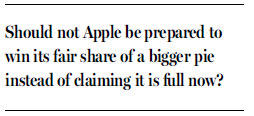In China, glass is barely half full for Apple
By Zhu Qiwen (China Daily) Updated: 2016-01-29 08:13
But in the absence of such signs, Apple's sales do not support media headlines like "With China weakening, Apple turns to India" or "China's smartphone slowdown bites Apples". Total iPhone sales grew 76 percent in India, Apple said. That kind of growth should be exciting, but the gap between the average 450,000 smartphone shipments per quarter in India in 2015 and more than 15 million per quarter in China seems less wide than that between the reality and illusion depicted by the headlines.
Perhaps that's why Apple CEO Tim Cook insisted: "We remain very bullish on China, and, you know, don't subscribe to the doom and gloom kind of predictions frankly."
On the global front, the saturating demand for smartphones, especially high-end ones like iPhones, is a worry as a repeat of 2008 looms over the world economy. Yet the potential of the Chinese market has not been fully tapped by either Apple or its rising rivals. Chinese consumers' appetite for innovative products can only intensify with the steady increase in the country's average income. China's urban per capita disposable income reached 31,195 yuan ($4742.28) in 2015, compared with 19,109.4 yuan in 2010. Although the more than 50 percent rise does not mean the next five years will see similar income growth or Chinese consumers will always ignore economic slowdown, it does indicate that, as the price of iPhone as a share of their income continuously declines, it is more than likely that their demand will not peak any time soon.
Moreover, the capability of Chinese companies to provide more smartphones to compete with Apple should also be appreciated as part of the country's efforts to promote supply-side reform aimed at significantly expanding the width and depth of the consumer market.
Should not Apple be prepared to win its fair share of a bigger pie instead of claiming it is full now?
The author is a senior writer with China Daily. zhuqiwen@chinadaily.com.cn

I’ve lived in China for quite a considerable time including my graduate school years, travelled and worked in a few cities and still choose my destination taking into consideration the density of smog or PM2.5 particulate matter in the region.











